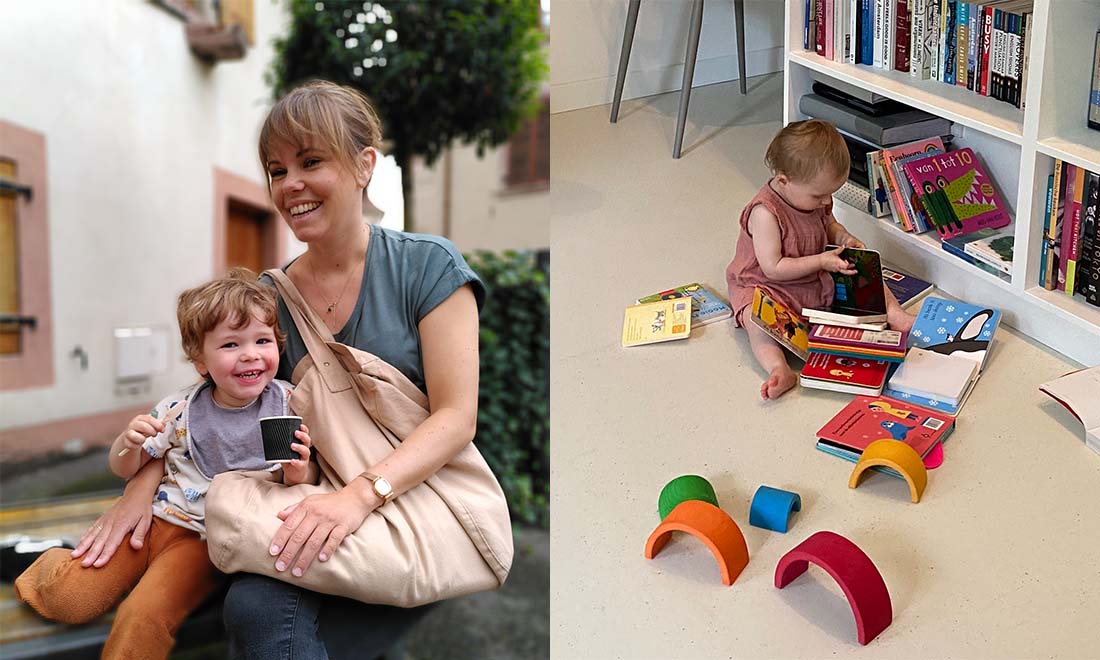What language(s) do you speak with your children if they grow up in a different country than the place where you were raised yourself? In honor of Unesco’s International Mother Language Day, we asked our teachers Francesca (Italian) and Samanthya (English), who are also mothers, to tell us about the language they speak with their children, and what it’s like raising them to be bilingual or even trilingual. In the above photo you can see Francesca with her daughter Meera on the left and Eli and Theo, Samanthya’s children, on the right.
Samanthya, mother of Eli (7) and Theo (3)
Before either of my kids was born, I knew that I was going to be raising bilingual kids, but I never imagined I would actually be raising trilingual kids! But, fate had other plans, and we ended up in the Netherlands after nine years of living in Colombia, where my two sons, Eli and Theo were born. While living in a Spanish-speaking country, it was easy to balance two languages. I spoke English with the kids, and my Colombian husband, his family, and most of society spoke Spanish with them.
The boys were four and one when we moved to the Netherlands, and when we arrived here in Amsterdam, it was a steep learning curve while figuring out how to juggle three languages. At the time, my younger son was just beginning to say individual words — owl and carro were two of his first, and we were genuinely delighted to hear his brand new voice emerge in both Spanish and English. My older son, who had started Spanish-language preschool in Colombia a year before, was suddenly thrown into a Dutch school six weeks after his fourth birthday and not long after, decided he wanted nothing to do with Spanish. Looking back now, I can only imagine how lost he must have felt, but of course, he caught on quickly as kids generally do, and we adults soon realized that our English and Spanish would only get us so far when it came to school reports and playdates.
We started learning Dutch alongside our older son and tried to find the right balance between our family languages and the language of our new home. The first year or so adapting as a trilingual family was tricky, but we’ve now found a balance that works for us. While one person, one language is often touted as the golden key to raising multilingual kids, it just didn’t work for us. We’ve taken a more situational approach — most of our family time is spent speaking English, but we have Spanish TV time every afternoon, often listen to Spanish-language music at dinner, read at least one Spanish book before bed, and Dad speaks Spanish when he remembers!
Three and a half years have gone by since we first landed in the Netherlands, and more and more often I hear Eli and Theo speaking Dutch between themselves. I love hearing my kids’ voices grow and become stronger in all three languages, but I do have to admit that I miss their early feats of linguistic acrobatics, like one of my all-time favorite sentences from little Theo: Mamá, mamá, mira, look over there, een boerderij!
Francesca, mother of Meera (5)

Languages carry a lot with them: culture, sounds, history, and for me, most of all emotions. That is why there has never been any doubt for me that the language I wanted to speak to my daughter Meera, born here in Amsterdam, was Italian, my mother tongue. This is the language that connects me to my deepest emotions and passions, the one that creates a fil rouge in the narrative of my strongest relationships with people and with places. I come from Sardinia, where I grew up speaking Italian, even though many of my relatives also spoke Sardinian. This is why also Sardinian language has a space in my family’s emotional universe, because it has a special strength to it and it just expresses some concepts better for us.
My daughter is now 5, my husband speaks Dutch to her and I speak Italian, but at home she also hears a lot of English. So now she is trying to find her balance between these languages, while also getting Dutch input at school. Meera always speaks Italian to me, and especially when she needs to express a strong emotion she goes full Italian, using her hands and facial expressions to underline what she is saying – sometimes shouting – in Italian.
Sometimes she struggles to remember a word and she uses the Dutch one instead, creating beautiful mixes of Dutch vocabulary and Italian morphology (grammar geeks like me will appreciate this). The other day she got sick and had to vomit, so she called me from the other room shouting: “Mamma, ho kotzato!” – kotsen is Dutch for vomiting and –ato is the suffix for the past participle in Italian.
The situation gets even more complicated when we go to Sardinia, and my family starts feeding her with local expressions and words. There she is picciocchedda (little girl in Sardinian) to my dad and my mom, and if I do something stupid or funny she will tell me that I have to use my conca (Sardinian for head, instead of the Italian testa).
I love that she is growing up so multilingual and with so many different ways of expressing herself. I think these languages will give her a chance not only to put her inner world into words, but also to get closer to the ones of other people, all these mixes of experiences, culture, history and emotions. Languages helped me a lot to understand other realities and to give voice to parts of me that I didn’t even know existed and I hope, in my very idealistic way, that in the future people like Meera can even help us bridge the gap of misunderstanding and stereotypes when interacting among different cultures.


